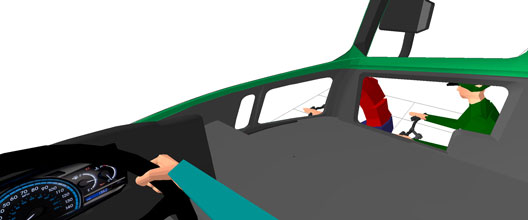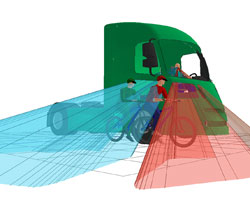Latest news from Loughborough University

23 Sep 2014
Direct Vision lorries would save hundreds of lives, says Loughborough study

A longer, more aerodynamic cab with better vision for lorry drivers could save the lives of hundreds of cyclists and pedestrians, according to a new study by academics at Loughborough University’s Design School.
The proposed new cab, 80cm longer with a rounded nose, smaller dashboard, expanded glazed areas, and a slightly lower driver position, could drastically reduce blind spots around the lorry.
The ‘Direct Vision’ lorry concept would increase the driver’s field of view in front and to the sides of the lorry by 50 per cent compared to today’s lorry designs and could save the lives of cyclists and pedestrians.
That’s the major finding of a study by Dr Steve Summerskill and Dr Russell Marshall, from the Loughborough Design School (1), which was commissioned by Transport for London (TfL) and Transport & Environment (T&E).
Dr Summerskill, project lead of the ‘Direct Vision’ concept, said: “Blind Spots can be a significant factor in fatal accidents. The study shows that the size of these blind spots can be minimised through improved cab design, the reduction of cab height and the addition of extra windows.
“This is a key moment in the definition of truck design legislation at the European level. Our work is being used to demonstrate that improvements to vehicle aerodynamics must go hand in hand with improvements that allow heavy goods vehicle (HGV) drivers to have improved vision of vulnerable road users around the vehicle.”
William Todts, senior policy officer at T&E, said: “Not only drivers, but politicians too need vision.
“It’s incomprehensible that we allow huge 40 ton mammoths on our roads without making sure the people behind the wheel can actually see what’s going on.
“After decades of tinkering with mirrors, we need to take this once-in-a-generation opportunity and make direct vision compulsory for new lorry designs.”
The study comes at a time when there is increasing concern over the number of deaths among cyclists and pedestrians involving HGVs.
Last year, for instance, nine of the 14 cyclists killed in London involved HGVs.
In July, supermarket giant Sainsbury’s unveiled a high-tech lorry for service in London, and Mayor Boris Johnson announced moves to ban some lorries from the streets altogether.
Outdated, brick-shaped lorry cabs are part of the reason why lorries have a deadly track record. Today’s cab design forces the driver to sit on top of the engine in such a high position that much of what happens around the cab is invisible to them – the so-called fatal blind spots (2).
According to the European Transport Safety Council, lorries are involved in around 4,200 fatal accidents in Europe every year. Many of these fatalities, almost 1,000 (3), are vulnerable road users such as cyclists and pedestrians.
In countries with high rates of cycling, lorries are often the single biggest threat to cyclists. In Belgium, 43 per cent of cycling fatalities involve lorries, in Holland 38 per cent and in the UK 33 per cent.
The study analysed 704 accidents involving HGVs and found that 31 per cent of road fatalities were caused by drivers pulling away, 19 per cent were caused by left turns, seven per cent by right turns, and 25 per cent from drivers reversing.
Surprisingly, vehicles changing lanes were responsible for half of all accidents, but no fatalities.
The analysis indicates that ‘critical blind spots’ in current models cannot be compensated for by the use of a lorry driver’s mirrors, because of the time lapse between checking them, making observations through the window, and then pulling away from a junction.
“If this time period is four seconds, this is enough time for a cyclist to undertake the HGV, with the driver being unaware of his or her presence,” the paper says.
There are two legal roadblocks holding back safer, more fuel-efficient lorries.
Firstly, unlike for cars, Europe has no rules guiding what a lorry driver should be able to see with his own eyes (direct vision).
Instead, European rules focus on indirect vision (through mirrors), but while mirrors are useful, the multitude of mirrors and their often distorted images are no substitute for decent direct vision.
Secondly, the current EU law on weight and dimensions of lorries has forced a design that has particularly large blind spots.
Europe has proposed changing this law to allow (but not mandate) slightly longer (80-90cm), more aerodynamic lorry designs. New designs would need to comply with additional safety requirements but these still need to be developed.
For more information:
Regarding EU law, please contact:
William Todts – Transport & Environment (T&E)
William.todts@transportenvironment.org
+32 495 799505
Regarding lorry design improvements, please contact:
Steve Summerskill, Loughborough Design School
s.j.summerskill2@lboro.ac.uK
Notes for editors
Article reference number: PR 14/166
(1) The University of Loughborough, and its Design School in particular, is an authority in the field of direct vision. Its work underpinned the UK’s 2011 amendment to UNECE Regulation 46 regulating lorry mirrors. The study for Transport for London and T&E is based on the same methodology and it aims to scientifically and visually describe how different designs impact direct vision.
(2) The European Commission acknowledges this fact: “blind spots are a major factor in many accidents involving lorries”.
(3) FKA, Design of a Tractor for Optimised Safety and Fuel Consumption 2011, p68.
Loughborough is one of the country’s leading universities, with an international reputation for research that matters, excellence in teaching, strong links with industry, and unrivalled achievement in sport and its underpinning academic disciplines.
It has been awarded five stars in the independent QS Stars university rating scheme, putting it among the best universities in the world, and was named Sports University of the Year 2013-14 by The Times and Sunday Times. Loughborough is ranked in the top fifteen of UK universities and has been voted England's Best Student Experience for six years running in the Times Higher Education league. In recognition of its contribution to the sector, Loughborough has been awarded seven Queen's Anniversary Prizes.
In 2015 the University will open an additional academic campus in London’s new innovation quarter. Loughborough University in London, based on the Queen Elizabeth Olympic Park, will offer postgraduate and executive-level education, as well as research and enterprise opportunities.
Contact for all media enquiries
Chris Goddard
Public Relations Officer
Loughborough University
T: 01509 228697
E: C.J.Goddard@lboro.ac.uk